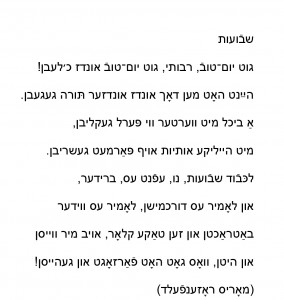A celebration of the giving of the Torah at Mount Sinai
Shavuot
Good holiday, gentlemen, a great holiday for us!
Today is the day we were given the Torah.
A little book with words picked like pearls,
With holy letters written on parchment.
In Shavuot’s honor, come, open it, brothers,
And let us leaf through it, let us again
Study and clearly see,
If we know and observe
What God has allowed and commanded.
From the Jewish perspective, God revealed two Torahs to Moses at Mount Sinai. Not only the Torah in the sense of the Hebrew Bible i.e. the “written Torah,” but an “oral Torah” was also revealed. It is this second Torah which is key to attaining a full understanding of the written Torah. As the name suggests, this “oral Torah” was subsequently handed down by word of mouth over many generations, finally finding its written expression in rabbinic literature. The twofold Torah contains the law revealed by God with all its moral and ritual elements. The form these laws take is the product of an ongoing discourse which is continually wrangling with decisions on novel situations across different times and places, thus making change possible and continuity tangible.
Given this inherent changeability, Judaism, as such, has changed over the course of time. The faith of the patriarchs has been harmonized with the legislation from the Sinai, with the prophets’ idealism and with the practical concerns of the rabbis. It has taken account of the prevailing social conditions in different eras and reacted accordingly to contemporary lifestyles and attitudes without just slavishly imitating its environment.
A partnership in revelation
 It is only possible to ‘believe’ in what was previously experienced as a commandment and heard as an answer to the questions of one’s own life. This move to relativize came to the fore during the Talmudic period when there was both a lively discussion and critical examination of the principles of Jewish law. Customs that could no longer be maintained were successfully abolished after careful revision of texts and through a process of interpretation which gave alternative meanings to previous literal readings of the Torah.
It is only possible to ‘believe’ in what was previously experienced as a commandment and heard as an answer to the questions of one’s own life. This move to relativize came to the fore during the Talmudic period when there was both a lively discussion and critical examination of the principles of Jewish law. Customs that could no longer be maintained were successfully abolished after careful revision of texts and through a process of interpretation which gave alternative meanings to previous literal readings of the Torah.
Consider how rabbis attached so many conditions to the death penalty that it became impossible to impose a capital sentence. Or how the principle “an eye for an eye, a tooth for a tooth” (Ex. 21:24) was dissociated from any physical retribution and was instead reinterpreted to rationalize financial compensation.
Later on, rabbinic decisions were employed to do away with laws perceived to have negative effects. Hillel (20 BCE-20 CE) for example, made it possible to enforce the repayment of loans during Sabbatical years. Previously, these debts had been allowed to lapse in concurrence with Biblical commandments. Hillel instead argued that a statement could be made before a court to the effect that the law requiring the annulment of debts upon the beginning of the Sabbatical year should not apply to the loan in question. This declaration was to be attested by witnesses or by the judges of the court before whom the declaration was made (Sheb. X. 4).
As a further example of the degree to which traditional Judaism approved of changes in the past, we should remember that in the second century CE Sabbath services lasted an hour, Torah readings had been translated into the vernacular, prayers differed from community to community, and men did not cover their heads. Men were also permitted to have more than one wife with whom he presumably shared a pew during services.
In summary, we can safely say that Judaism believes in a progressive process of revelation. It begins from the presupposition that the will of God discloses itself in an ongoing way and can be construed differently from the interpretations of the past. This concept of revelation makes it possible to relativize the written Torah with the help of the oral Torah. Using interpretation, we can thus build a bridge between rational insight and the text of the revelation. We know for a fact that these questions were discussed by Talmudic scholars in free ideological exchanges with their contemporary philosophers. To be sure, the various denominations within Judaism differ in regard to the intensity with which they accept this interpretative thesis. Some degree of interpretative flexibility however is common throughout the faith.
Zeman Matan Torateinu
Initially the thanksgiving day of the wheat harvest, Shavuot is called the time of the giving of the Torah, Zeman Matan Torateinu, rather than the time of the receiving of the Torah. As the sages make clear, we are constantly involved in the process of receiving the Torah, in fact, we receive it every day.
In the famous story about Moses’ visit to Rabbi Akiba’s school we already find the position that the revelation on Sinai had only established a certain framework: “Rab Judah said in the name of Rab: ‘When Moses ascended on high he found the Holy One, blessed be He, engaged in affixing coronets to the letters.’ Said Moses: ‘Lord of the Universe, Who stays Thy hand?’ He answered, ‘There will arise a man, at the end of many generations, Akiba b. Joseph by name, who will expound upon each title heaps and heaps of laws.’ ‘Lord of the universe,’ said Moses, ‘permit me to see him.’ He replied: ‘Turn thee round.’ Moses went and sat down behind eight rows [and listened to the discourses upon the law]. Not being able to follow their arguments he was ill at ease; but when they came to a certain subject and the disciples said to the master ‘Whence do you know it?’ and the latter replied ‘It is a law given unto Moses at Sinai’ he was comforted.”
From generation to generation, this legal framework is developed and enriched through scholarly interpretation where it is modified or relativized. In this process, human reason is given a major role in the knowledge of what God requires of us human beings.
Many hold parts of the truth
The right decision is made on earth, not in heaven. In his commentary on Erubin 13b, Rabbi Yom Tov ben Avraham Asevilli from Seville (1250-1330), known as “Ritva,” writes the following: “The rabbis of France asked: ‘How can it be that both opinions are the word of the living God, since one says that a certain thing is prohibited and the other that it is permitted?’
They answered that when Moses went up to the heavens to receive the Torah, he was shown 49 ways of prohibiting and 49 ways of permitting each thing. When Moses asked the Holy One about this, he was told that this is to be entrusted to the sages of Israel in every generation and the decision will be in their hands.”
The revelation on Mount Sinai can be interpreted in different ways using human reason as a source of insight. Every human being should look at the revelation as if he or she had been present during the liberation from Egypt. It is thus possible for, and also the duty of, each and every Jew to strive for an understanding of God’s demands and transfer them into their time.
The Jewish businesswoman and diarist Glückel of Hamelin (1646-1724), summed up these thoughts succinctly when she wrote, “We can hold firm to our dear Torah but we human beings have been given the choice to act as we please. In the Torah much is written about reward and punishment for good and evil deeds, ‘but choose life.’”
Rabbi Dr. Walter Homolka is rector of the Abraham Geiger College at the University of Potsdam
